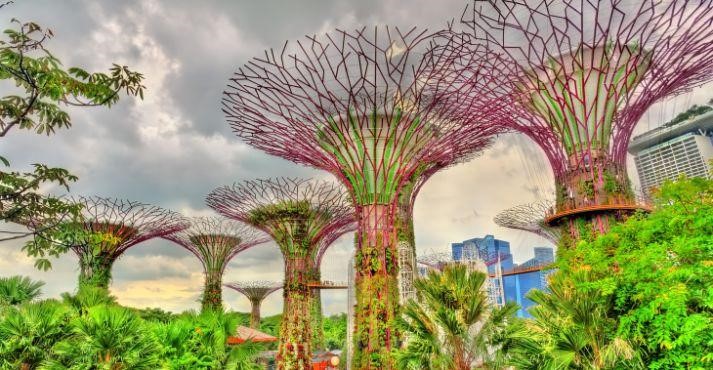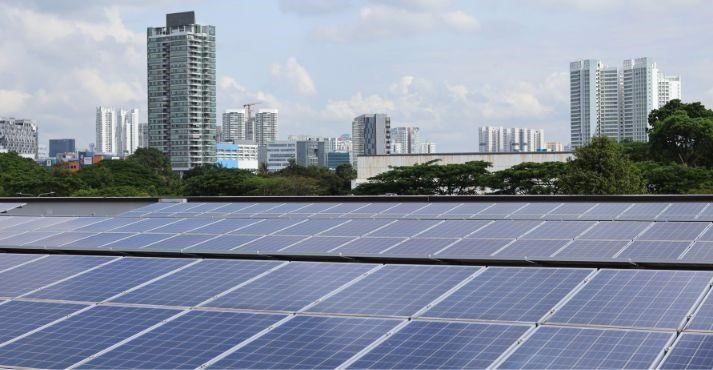The Singapore Green Plan 2030 is a comprehensive strategy launched in February 2021 to advance Singapore’s national agenda on sustainable development.
This ambitious plan aims to promote sustainability and environmental conservation across all sectors of society, addressing critical issues such as climate change, biodiversity loss, and resource sustainability.
Significantly, the Green Plan targets reducing Singapore’s carbon emissions, increasing urban greenery, and raising a green economy.
With global temperatures rising and natural habitats declining, the plan sets a robust framework for mitigating these impacts and ensuring a sustainable future.
For instance, Singapore aims to quadruple its solar energy deployment by 2030, which could generate enough electricity to power around 350,000 households annually.
Designed to be a “whole-of-nation” movement, the Singapore Green Plan 2030 involves collaborative efforts from government agencies, businesses, and the public, making it a pivotal initiative for securing Singapore’s greener, more resilient future.
What is the Singapore Green Plan 2030?

The Singapore Green Plan 2030 is a national blueprint that sets forth Singapore’s long-term goals and strategies for environmental sustainability over the next decade.
Launched in February 2021, this comprehensive plan aims to transform Singapore into a sustainable and resilient city, aligning with global sustainability efforts such as the United Nations’ 2030 Sustainable Development Agenda and the Paris Agreement.
The 2030 Green Plan addresses pressing environmental challenges, including climate change, biodiversity loss, and resource sustainability.
It outlines a range of ambitious targets, such as planting 1 million more trees, quadrupling solar energy deployment by 2025, and reducing waste sent to landfills by 30% by 2030. These targets aim to reduce Singapore’s carbon footprint and enhance its environmental resilience.
The Singapore Green Plan 2030 is spearheaded by five key ministries: Education, National Development, Sustainability and the Environment, Trade and Industry, and Transport.
This whole-of-nation approach ensures that sustainability efforts are integrated across various sectors, influencing all aspects of life, from infrastructure development to community engagement.
By promoting green initiatives and sustainable practices in Singapore, the Green Plan seeks to mobilize collective action from all Singaporeans, including individuals, businesses, and government agencies.
The goal is to build a greener, more livable home for future generations, demonstrating Singapore’s commitment to environmental stewardship and sustainability leadership on a global scale.
Why is the Green Plan Important?

The Singapore Green Plan 2030 is significant for sustainability issues in Singapore and the broader Southeast Asian region. Its comprehensive approach to sustainability addresses critical environmental issues and sets a precedent for other nations.
Addressing Climate Change
- Reducing Carbon Footprint: One of the central aims of the Green Plan is to significantly reduce Singapore’s carbon footprint. This involves ambitious targets such as quadrupling solar energy deployment by 2025 and transitioning all newly registered cars to cleaner-energy models from 2030. These measures are essential for mitigating the effects of climate change and reducing greenhouse gas emissions.
- Mitigating Climate Effects: The plan seeks to lower urban temperatures, improve air quality, and increase biodiversity by enhancing urban greenery and implementing environmental sustainability in Singapore. For example, planting 1 million more trees by 2030 will help absorb carbon dioxide, provide natural cooling, and contribute to a healthier environment.
Building a Sustainable Future
- Livable and Resource-Efficient City: The Singapore Green Plan 2030 aims to make Singapore more livable and resource-efficient. This includes initiatives like reducing waste sent to landfills by 30% by 2030 and promoting sustainable living practices among citizens. The plan’s focus on resource efficiency ensures that natural resources are used judiciously, minimizing waste and maximizing sustainability.
- Climate Resilience: Preparing for future environmental challenges is another critical aspect of the Green Plan. By investing in research and innovation, Singapore aims to develop new technologies and solutions that improve climate resilience. This includes exploring low-carbon alternatives and improving energy efficiency across various sectors for sustainability in Singapore.
Leading by Example
- Inspiring the Region: Singapore’s comprehensive green initiatives under the Green Plan serve as a model for other countries in Southeast Asia. By demonstrating practical strategies for sustainable development, Singapore can inspire neighboring countries to adopt similar measures. The plan underscores Singapore’s commitment to global sustainability goals, including the UN’s SDG, and showcases how national efforts can contribute to global environmental health.
- Regional Leadership: As a leading city-state in Southeast Asia, Singapore’s proactive approach to sustainability can drive regional efforts to combat climate change and promote environmental conservation. The success of the Singapore Green Plan 2030 can encourage other nations to implement robust sustainability strategies, fostering a collective effort towards a greener future.
The Five Pillars of SGP 2030

The Singapore Green Plan 2030 is structured around five key pillars that collectively aim to create a sustainable and resilient future for Singapore.
These pillars are City in Nature, Sustainable Living, Energy Reset, Green Economy, and Resilient Future. Each pillar focuses on specific areas of environmental sustainability and sets ambitious targets to be achieved by 2030.
1. City in Nature
The City in Nature pillar aims to develop Singapore’s green spaces, promote urban biodiversity, and develop a connection with nature within the city. This involves creating new parks, community gardens, and green corridors that integrate nature into urban areas.
- New Parks and Green Spaces: Singapore plans to increase its nature parkland by over 50% by 2030. This means more areas where people can enjoy hiking and bird-watching activities.
- Community Gardens: Encouraging the development of community gardens allows residents to grow their vegetables and plants, fostering a sense of community and connection to nature.
- Green Corridors: Creating green corridors that connect different parts of the city helps wildlife move freely and safely, promoting biodiversity.
By developing urban greenery, Singapore aims to improve air quality, reduce urban heat, and provide more recreational spaces for its residents, which aligns with Singapore’s sustainable development goals.
2. Sustainable Living
The Sustainable Living pillar encourages a more sustainable lifestyle among Singapore residents. This includes promoting responsible food consumption, waste reduction, and energy conservation.
- Eco-Friendly Practices: Residents are encouraged to adopt eco-friendly practices such as recycling, composting, and using sustainable products like sustainable foods.
- Reducing Single-Use Plastics: The plan aims to reduce reliance on single-use plastics by promoting the use of reusable items like sustainable packaging, water bottles, and shopping bags.
- Responsible Water Usage: Encouraging responsible water usage helps conserve this vital resource. Simple actions like fixing leaks and using water-saving devices can make a big difference.
3. Energy Reset
The Energy Reset pillar focuses on transitioning Singapore’s energy sector towards cleaner and more sustainable sources like solar power and natural gas.
- Increasing Solar Energy Deployment: Singapore aims to significantly increase its solar energy capacity. By 2025, the goal is to generate enough solar energy to power around 350,000 households annually.
- Improving Energy Efficiency in Buildings: Enhancing energy efficiency in buildings through the Green Mark scheme helps reduce energy consumption and lower carbon emissions.
- Exploring Alternative Energy Sources: The plan also involves exploring alternative energy sources, such as hydrogen and other low-carbon technologies, to diversify Singapore’s energy mix.
These efforts are crucial for reducing Singapore’s dependence on fossil fuels and lowering greenhouse gas emissions.
4. Green Economy
The Green Economy pillar aims to position Singapore as a global leader in the green economy by attracting green investments and developing innovative sustainability solutions.
- Supporting Green Businesses: The Enterprise Sustainability Programme supports businesses, especially SMEs, to adopt sustainable practices and technologies.
- Developing Green Finance Initiatives: Singapore aims to become Asia’s leading center for green finance. This includes initiatives like issuing green bonds to fund sustainable infrastructure projects.
- Fostering Research and Development: Investing in research and development helps drive innovation in clean technologies and sustainability solutions, supporting the growth of the green economy in Singapore.
By focusing on these areas, Singapore can create new job opportunities, foster economic growth, and ensure environmental sustainability.
5. Resilient Future
The Resilient Future pillar focuses on preparing Singapore for the impacts of climate change, such as rising sea levels and extreme weather events.
- Coastal Protection Infrastructure: Investing in coastal protection infrastructure, like sea walls and flood barriers, helps protect Singapore from rising sea levels.
- Climate-Resilient Urban Planning: Incorporating climate resilience into urban planning ensures that buildings and infrastructure can withstand extreme weather events.
- Raising Awareness: This pillar includes critical components such as educating the public about climate change risks and promoting community involvement in resilience efforts.
These initiatives aim to make Singapore more resilient to the adverse effects of climate change and ensure the safety and well-being of its residents as per the Singapore Sustainability Plan 2030.
The Green Plan in Action: Achievements and Future Developments

The Singapore Green Plan 2030 has made significant progress since its launch, with several vital achievements and ongoing developments. This section highlights the milestones reached so far, the challenges faced, and the opportunities ahead.
Progress on SGP 2030 Goals
The Singapore Green Plan 2030 has already seen notable progress in various areas. Here are some of the key achievements and milestones:
- Increase in Solar Energy Capacity: One of the standout achievements has been the significant increase in solar energy capacity. Singapore has made strides in installing solar panels on rooftops of Housing Development Board flats, commercial buildings, and even on water surfaces. This effort contributes to the goal of quadrupling solar energy deployment by 2025, aiming to generate enough electricity to power around 350,000 households annually.
- Launch of Car-Lite Zones: To promote green initiatives in Singapore under transportation, Singapore has introduced car-lite zones in various parts of the city. These areas prioritize walking, cycling, and public transport over car usage. For example, the Kampong Bugis area is being developed as a car-lite precinct with extensive cycling paths and pedestrian-friendly streets.
- Public Education Campaigns: Raising awareness about sustainability is crucial for the success of the Green Plan. The government has launched numerous public education campaigns to encourage eco-friendly practices among residents. These campaigns focus on recycling, reducing single-use plastics, and conserving water.
- Community Gardens and Green Spaces: The development of community gardens and the expansion of green spaces have been significant achievements under the City in Nature These initiatives enhance urban greenery and create a sense of community and connection to nature among residents.
- Green Finance Initiatives: Singapore has made strides in becoming a leading center for green finance. The issuance of green bonds to fund sustainable projects and establishing the Green Finance Industry Taskforce are steps towards positioning Singapore as a global hub for green investments and establishing a green economy in Singapore.
Challenges and Opportunities
While there have been many successes, implementing the Singapore Green Plan 2030 presents several challenges. However, these challenges also offer opportunities for innovation and collaboration.
Challenges:
- Limited Land Space: As a small island nation, Singapore faces constraints in terms of land availability. Balancing the need for urban development with the preservation of green spaces is a constant challenge. Creative solutions, such as vertical farming and rooftop gardens, are being explored to maximize land use efficiently.
- Balancing Economic Growth with Environmental Sustainability: Ensuring economic growth while maintaining environmental sustainability is complex. The transition to a green economy requires substantial investments and shifts in business practices, which can be challenging for some industries.
Opportunities:
- Innovation in Sustainable Technologies: The challenges posed by the Green Plan drive innovation in sustainable technologies. For example, advancements in solar energy, energy-efficient building materials, and green transportation solutions are essential for achieving the plan’s goals. Initiatives like the Enterprise Sustainability Program support businesses in adopting these technologies.
- Regional Collaboration: Singapore’s efforts in sustainability can serve as a model for other Southeast Asian countries. Singapore can share knowledge, technologies, and strategies to tackle common environmental challenges by collaborating with neighboring nations. This regional cooperation can boost the overall impact of sustainability initiatives across Southeast Asia.
- Public-Private Partnerships: Collaboration between the government, private sector, and civil society is crucial for the success of the Green Plan. Public-private partnerships can drive the development and implementation of innovative sustainability projects. For instance, joint ventures in green finance, renewable energy, and sustainable urban planning can accelerate progress towards Singapore’s sustainable development goals.
- Raising Public Awareness and Participation: Engaging the public in sustainability efforts is essential. Educational campaigns and community involvement initiatives can increase awareness and encourage more people to adopt sustainable practices. Programs like community gardening and eco-friendly workshops help foster a culture of sustainability among residents.
Future Developments
The Singapore Green Plan 2030 will continue to build on its successes and address ongoing challenges. Future developments include:
- Expansion of Green Spaces: Continued efforts to expand parks, green corridors, and community gardens will further enhance urban greenery and biodiversity.
- Advancements in Renewable Energy: Increasing the deployment of solar energy and exploring other renewable sources, such as wind and hydrogen, will remain a priority.
- Strengthening Climate Resilience: It will be crucial to invest in infrastructure to protect against rising sea levels and extreme weather events. This includes developing flood barriers and drainage systems and implementing climate-resilient urban planning for environmental sustainability in Singapore.
- Promoting Sustainable Business Practices: Encouraging businesses to adopt sustainable practices through incentives, regulations, and support programs will drive the green economy forward.
Conclusion
The Singapore Green Plan 2030 represents a comprehensive and ambitious strategy to create a sustainable, resilient, and vibrant future for Singapore.
The plan focuses on key areas such as improving green spaces, promoting sustainable living, transitioning to clean energy, developing a green economy in Singapore, and building climate resilience.
It aims to address critical environmental challenges and improve the quality of life for all residents.
Significant progress has already been made, with notable achievements in solar energy deployment, the creation of car-lite zones, and public education campaigns.
Despite challenges like limited land space and balancing economic growth with sustainability, innovation and regional collaboration opportunities abound.
The success of the Green Plan relies on the collective efforts of the government, businesses, and the community. By working together and accepting sustainable practices, Singapore can serve as a model for other nations and create a greener, more sustainable world.





























